Detailed Marketing Plan for Bio-magnetic Watch in Australian Market
VerifiedAdded on 2020/03/23
|11
|2091
|66
Report
AI Summary
This report provides a comprehensive marketing plan for the launch of a bio-magnetic wristwatch in the Australian market. It begins with an executive summary and then delves into a detailed situational analysis, examining micro and macro-environmental factors, including intermediaries, customers, competitors, demographics, and technology. The report identifies opportunities, threats, strengths, and weaknesses, as well as key issues related to market segmentation and product differentiation. It outlines both short-term and long-term marketing objectives, followed by specific strategies for target segmentation, positioning, branding, and the marketing mix (product, place, price, promotion). Action programs, budget analysis, and methods for monitoring and controlling the marketing plan are also included, culminating in a conclusion and a list of references. The report aims to guide the successful introduction of the bio-magnetic watch, emphasizing its unique benefits and competitive advantages within the Australian market.

RUNNING HEAD: Market plan for Bio-magnetic watch
1
Marketing Plan-Biomagnetic watch
1
Marketing Plan-Biomagnetic watch
Paraphrase This Document
Need a fresh take? Get an instant paraphrase of this document with our AI Paraphraser
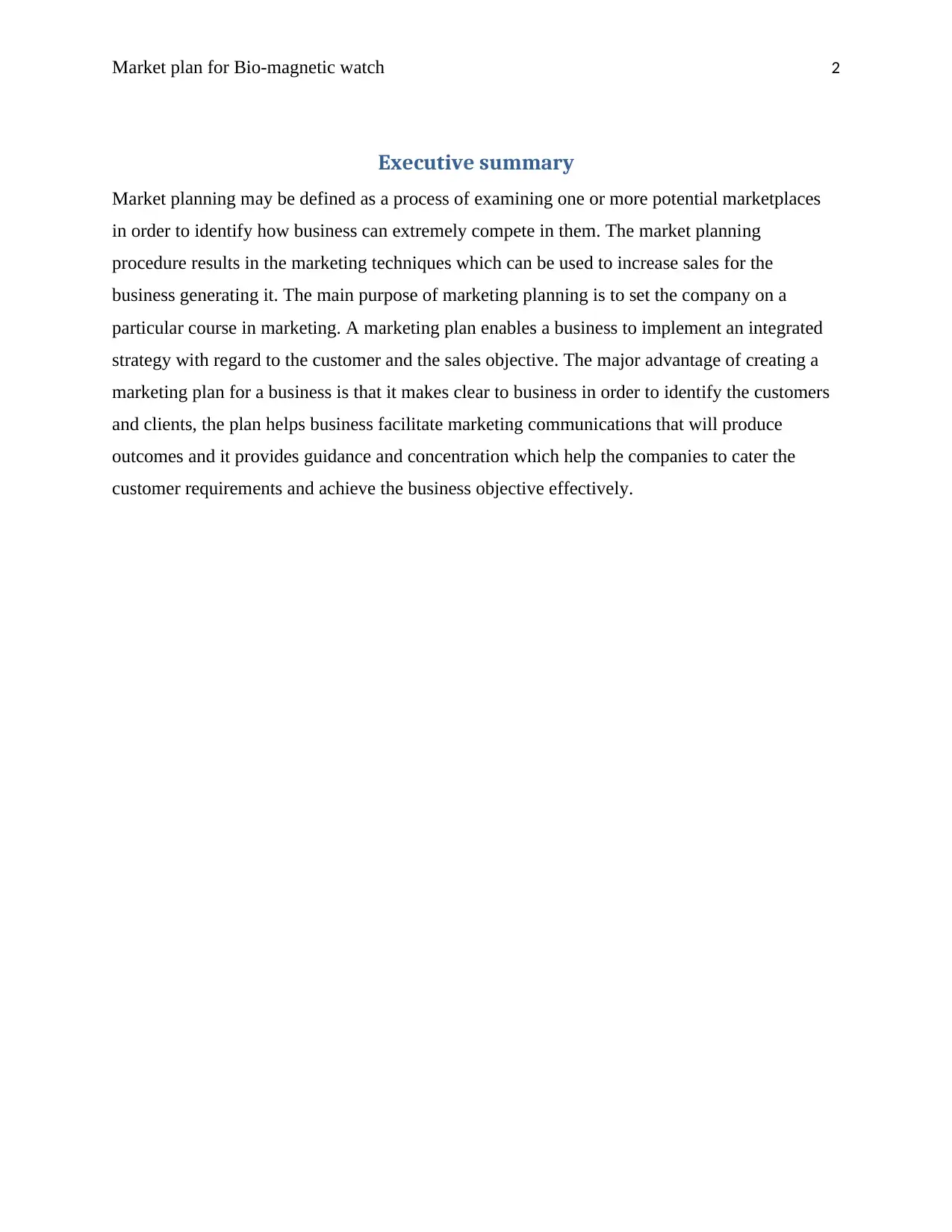
Market plan for Bio-magnetic watch 2
Executive summary
Market planning may be defined as a process of examining one or more potential marketplaces
in order to identify how business can extremely compete in them. The market planning
procedure results in the marketing techniques which can be used to increase sales for the
business generating it. The main purpose of marketing planning is to set the company on a
particular course in marketing. A marketing plan enables a business to implement an integrated
strategy with regard to the customer and the sales objective. The major advantage of creating a
marketing plan for a business is that it makes clear to business in order to identify the customers
and clients, the plan helps business facilitate marketing communications that will produce
outcomes and it provides guidance and concentration which help the companies to cater the
customer requirements and achieve the business objective effectively.
Executive summary
Market planning may be defined as a process of examining one or more potential marketplaces
in order to identify how business can extremely compete in them. The market planning
procedure results in the marketing techniques which can be used to increase sales for the
business generating it. The main purpose of marketing planning is to set the company on a
particular course in marketing. A marketing plan enables a business to implement an integrated
strategy with regard to the customer and the sales objective. The major advantage of creating a
marketing plan for a business is that it makes clear to business in order to identify the customers
and clients, the plan helps business facilitate marketing communications that will produce
outcomes and it provides guidance and concentration which help the companies to cater the
customer requirements and achieve the business objective effectively.
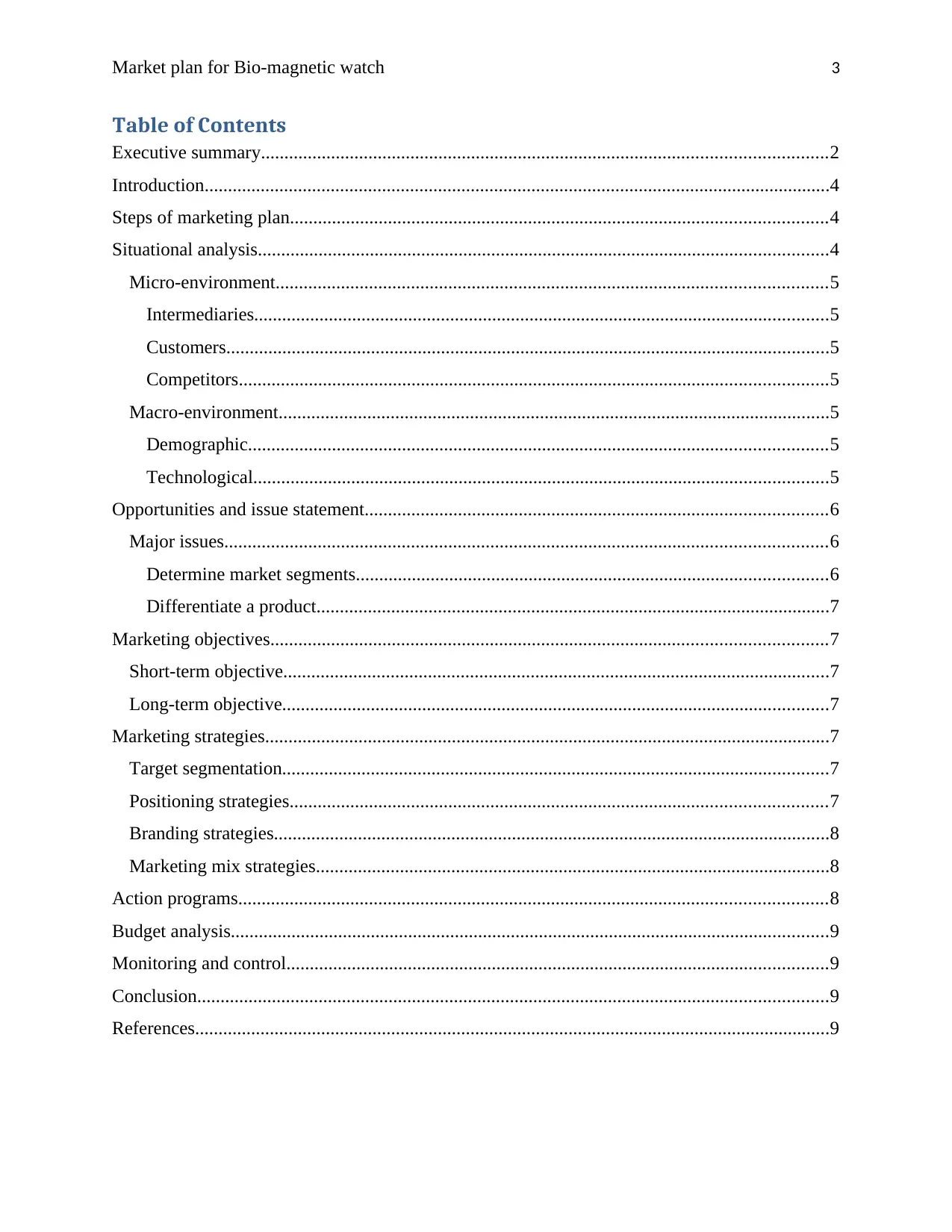
Market plan for Bio-magnetic watch 3
Table of Contents
Executive summary.........................................................................................................................2
Introduction......................................................................................................................................4
Steps of marketing plan...................................................................................................................4
Situational analysis..........................................................................................................................4
Micro-environment......................................................................................................................5
Intermediaries...........................................................................................................................5
Customers.................................................................................................................................5
Competitors..............................................................................................................................5
Macro-environment......................................................................................................................5
Demographic............................................................................................................................5
Technological...........................................................................................................................5
Opportunities and issue statement...................................................................................................6
Major issues.................................................................................................................................6
Determine market segments.....................................................................................................6
Differentiate a product..............................................................................................................7
Marketing objectives.......................................................................................................................7
Short-term objective.....................................................................................................................7
Long-term objective.....................................................................................................................7
Marketing strategies.........................................................................................................................7
Target segmentation.....................................................................................................................7
Positioning strategies...................................................................................................................7
Branding strategies.......................................................................................................................8
Marketing mix strategies..............................................................................................................8
Action programs..............................................................................................................................8
Budget analysis................................................................................................................................9
Monitoring and control....................................................................................................................9
Conclusion.......................................................................................................................................9
References........................................................................................................................................9
Table of Contents
Executive summary.........................................................................................................................2
Introduction......................................................................................................................................4
Steps of marketing plan...................................................................................................................4
Situational analysis..........................................................................................................................4
Micro-environment......................................................................................................................5
Intermediaries...........................................................................................................................5
Customers.................................................................................................................................5
Competitors..............................................................................................................................5
Macro-environment......................................................................................................................5
Demographic............................................................................................................................5
Technological...........................................................................................................................5
Opportunities and issue statement...................................................................................................6
Major issues.................................................................................................................................6
Determine market segments.....................................................................................................6
Differentiate a product..............................................................................................................7
Marketing objectives.......................................................................................................................7
Short-term objective.....................................................................................................................7
Long-term objective.....................................................................................................................7
Marketing strategies.........................................................................................................................7
Target segmentation.....................................................................................................................7
Positioning strategies...................................................................................................................7
Branding strategies.......................................................................................................................8
Marketing mix strategies..............................................................................................................8
Action programs..............................................................................................................................8
Budget analysis................................................................................................................................9
Monitoring and control....................................................................................................................9
Conclusion.......................................................................................................................................9
References........................................................................................................................................9
⊘ This is a preview!⊘
Do you want full access?
Subscribe today to unlock all pages.

Trusted by 1+ million students worldwide
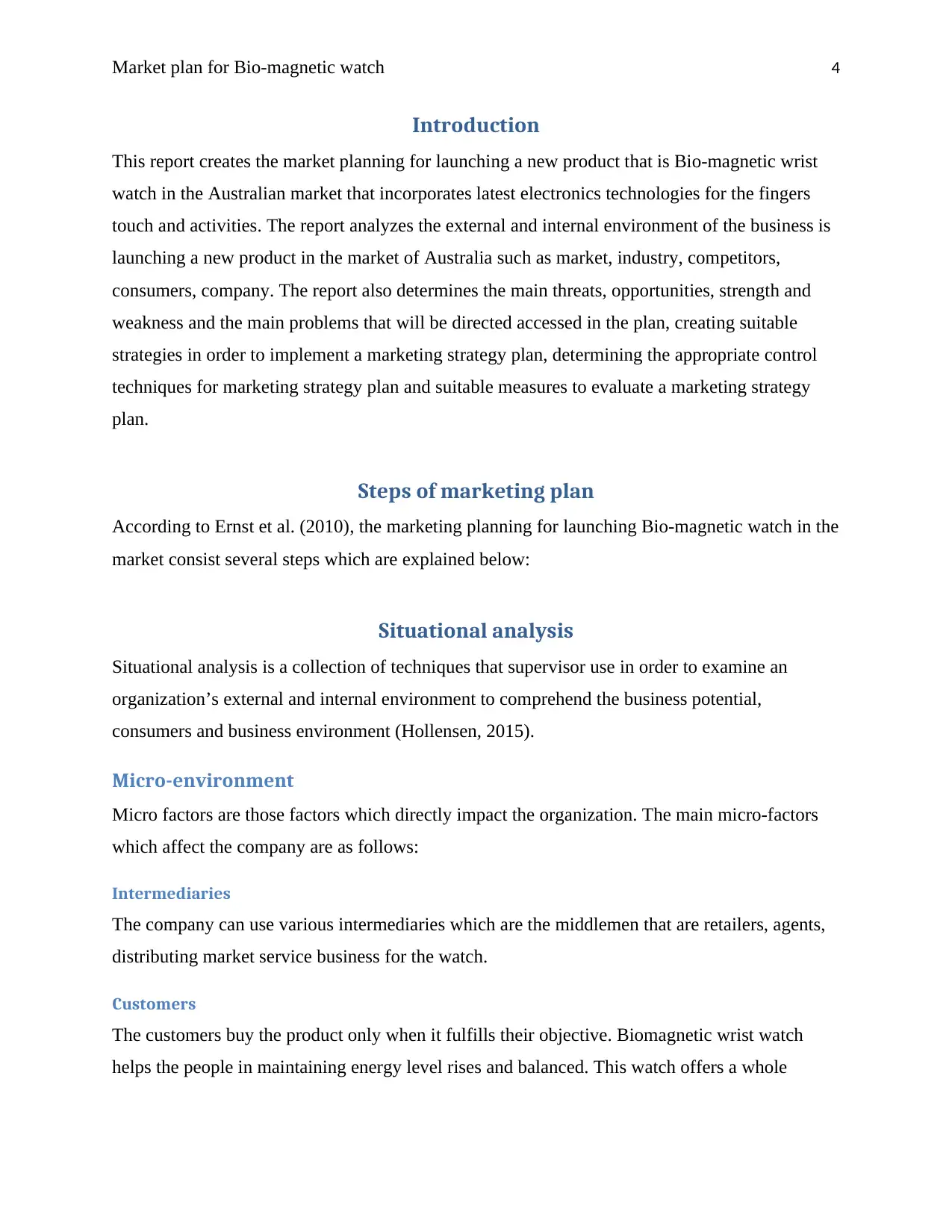
Market plan for Bio-magnetic watch 4
Introduction
This report creates the market planning for launching a new product that is Bio-magnetic wrist
watch in the Australian market that incorporates latest electronics technologies for the fingers
touch and activities. The report analyzes the external and internal environment of the business is
launching a new product in the market of Australia such as market, industry, competitors,
consumers, company. The report also determines the main threats, opportunities, strength and
weakness and the main problems that will be directed accessed in the plan, creating suitable
strategies in order to implement a marketing strategy plan, determining the appropriate control
techniques for marketing strategy plan and suitable measures to evaluate a marketing strategy
plan.
Steps of marketing plan
According to Ernst et al. (2010), the marketing planning for launching Bio-magnetic watch in the
market consist several steps which are explained below:
Situational analysis
Situational analysis is a collection of techniques that supervisor use in order to examine an
organization’s external and internal environment to comprehend the business potential,
consumers and business environment (Hollensen, 2015).
Micro-environment
Micro factors are those factors which directly impact the organization. The main micro-factors
which affect the company are as follows:
Intermediaries
The company can use various intermediaries which are the middlemen that are retailers, agents,
distributing market service business for the watch.
Customers
The customers buy the product only when it fulfills their objective. Biomagnetic wrist watch
helps the people in maintaining energy level rises and balanced. This watch offers a whole
Introduction
This report creates the market planning for launching a new product that is Bio-magnetic wrist
watch in the Australian market that incorporates latest electronics technologies for the fingers
touch and activities. The report analyzes the external and internal environment of the business is
launching a new product in the market of Australia such as market, industry, competitors,
consumers, company. The report also determines the main threats, opportunities, strength and
weakness and the main problems that will be directed accessed in the plan, creating suitable
strategies in order to implement a marketing strategy plan, determining the appropriate control
techniques for marketing strategy plan and suitable measures to evaluate a marketing strategy
plan.
Steps of marketing plan
According to Ernst et al. (2010), the marketing planning for launching Bio-magnetic watch in the
market consist several steps which are explained below:
Situational analysis
Situational analysis is a collection of techniques that supervisor use in order to examine an
organization’s external and internal environment to comprehend the business potential,
consumers and business environment (Hollensen, 2015).
Micro-environment
Micro factors are those factors which directly impact the organization. The main micro-factors
which affect the company are as follows:
Intermediaries
The company can use various intermediaries which are the middlemen that are retailers, agents,
distributing market service business for the watch.
Customers
The customers buy the product only when it fulfills their objective. Biomagnetic wrist watch
helps the people in maintaining energy level rises and balanced. This watch offers a whole
Paraphrase This Document
Need a fresh take? Get an instant paraphrase of this document with our AI Paraphraser
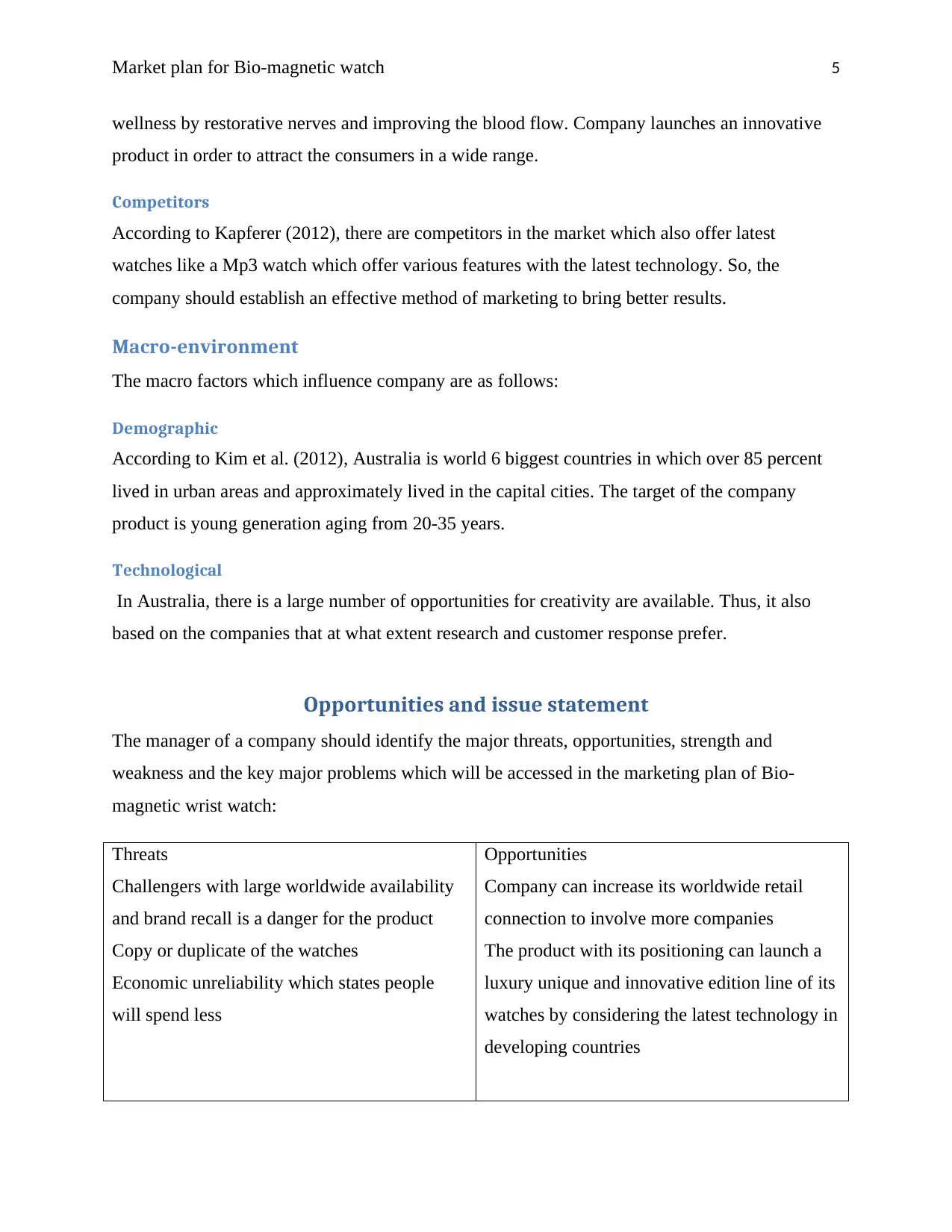
Market plan for Bio-magnetic watch 5
wellness by restorative nerves and improving the blood flow. Company launches an innovative
product in order to attract the consumers in a wide range.
Competitors
According to Kapferer (2012), there are competitors in the market which also offer latest
watches like a Mp3 watch which offer various features with the latest technology. So, the
company should establish an effective method of marketing to bring better results.
Macro-environment
The macro factors which influence company are as follows:
Demographic
According to Kim et al. (2012), Australia is world 6 biggest countries in which over 85 percent
lived in urban areas and approximately lived in the capital cities. The target of the company
product is young generation aging from 20-35 years.
Technological
In Australia, there is a large number of opportunities for creativity are available. Thus, it also
based on the companies that at what extent research and customer response prefer.
Opportunities and issue statement
The manager of a company should identify the major threats, opportunities, strength and
weakness and the key major problems which will be accessed in the marketing plan of Bio-
magnetic wrist watch:
Threats
Challengers with large worldwide availability
and brand recall is a danger for the product
Copy or duplicate of the watches
Economic unreliability which states people
will spend less
Opportunities
Company can increase its worldwide retail
connection to involve more companies
The product with its positioning can launch a
luxury unique and innovative edition line of its
watches by considering the latest technology in
developing countries
wellness by restorative nerves and improving the blood flow. Company launches an innovative
product in order to attract the consumers in a wide range.
Competitors
According to Kapferer (2012), there are competitors in the market which also offer latest
watches like a Mp3 watch which offer various features with the latest technology. So, the
company should establish an effective method of marketing to bring better results.
Macro-environment
The macro factors which influence company are as follows:
Demographic
According to Kim et al. (2012), Australia is world 6 biggest countries in which over 85 percent
lived in urban areas and approximately lived in the capital cities. The target of the company
product is young generation aging from 20-35 years.
Technological
In Australia, there is a large number of opportunities for creativity are available. Thus, it also
based on the companies that at what extent research and customer response prefer.
Opportunities and issue statement
The manager of a company should identify the major threats, opportunities, strength and
weakness and the key major problems which will be accessed in the marketing plan of Bio-
magnetic wrist watch:
Threats
Challengers with large worldwide availability
and brand recall is a danger for the product
Copy or duplicate of the watches
Economic unreliability which states people
will spend less
Opportunities
Company can increase its worldwide retail
connection to involve more companies
The product with its positioning can launch a
luxury unique and innovative edition line of its
watches by considering the latest technology in
developing countries
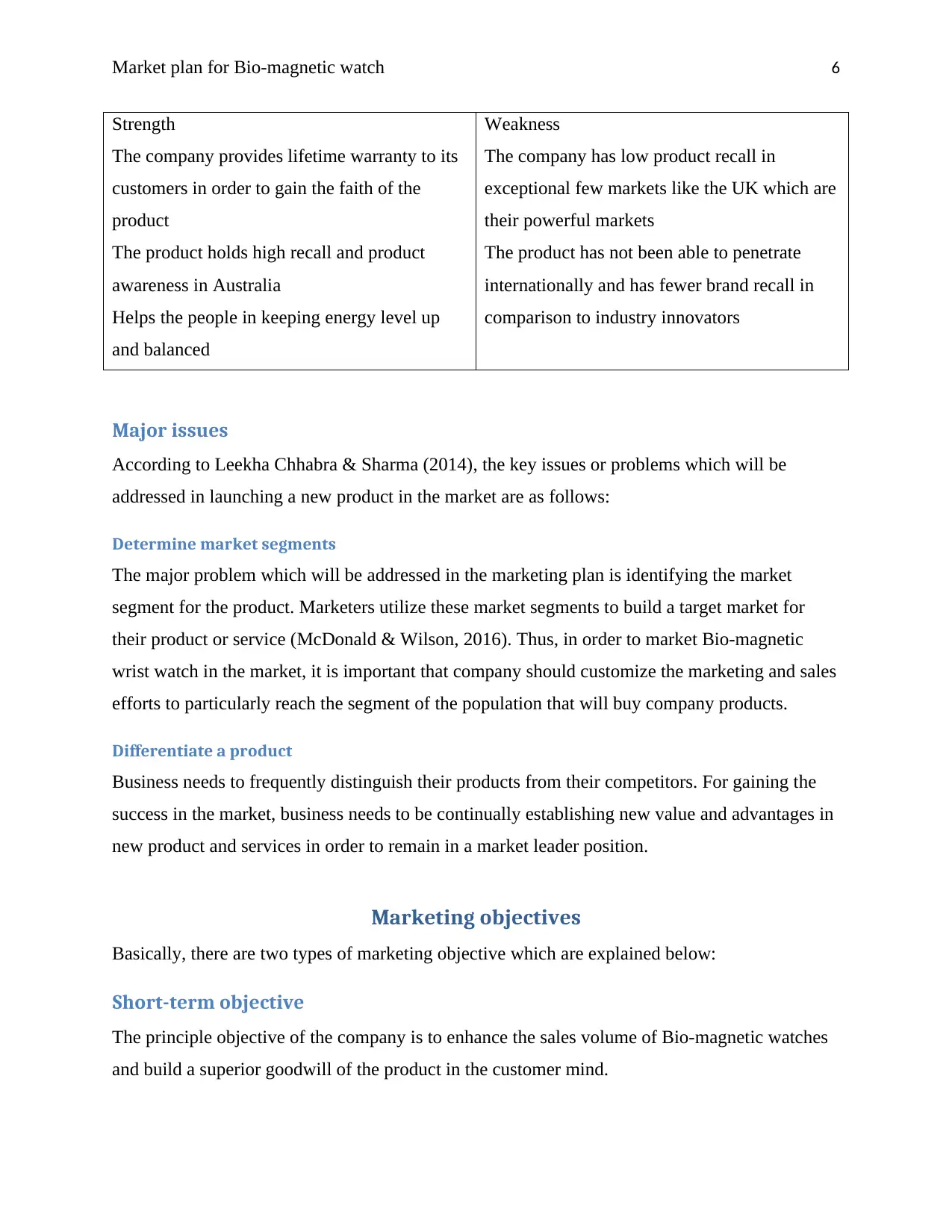
Market plan for Bio-magnetic watch 6
Strength
The company provides lifetime warranty to its
customers in order to gain the faith of the
product
The product holds high recall and product
awareness in Australia
Helps the people in keeping energy level up
and balanced
Weakness
The company has low product recall in
exceptional few markets like the UK which are
their powerful markets
The product has not been able to penetrate
internationally and has fewer brand recall in
comparison to industry innovators
Major issues
According to Leekha Chhabra & Sharma (2014), the key issues or problems which will be
addressed in launching a new product in the market are as follows:
Determine market segments
The major problem which will be addressed in the marketing plan is identifying the market
segment for the product. Marketers utilize these market segments to build a target market for
their product or service (McDonald & Wilson, 2016). Thus, in order to market Bio-magnetic
wrist watch in the market, it is important that company should customize the marketing and sales
efforts to particularly reach the segment of the population that will buy company products.
Differentiate a product
Business needs to frequently distinguish their products from their competitors. For gaining the
success in the market, business needs to be continually establishing new value and advantages in
new product and services in order to remain in a market leader position.
Marketing objectives
Basically, there are two types of marketing objective which are explained below:
Short-term objective
The principle objective of the company is to enhance the sales volume of Bio-magnetic watches
and build a superior goodwill of the product in the customer mind.
Strength
The company provides lifetime warranty to its
customers in order to gain the faith of the
product
The product holds high recall and product
awareness in Australia
Helps the people in keeping energy level up
and balanced
Weakness
The company has low product recall in
exceptional few markets like the UK which are
their powerful markets
The product has not been able to penetrate
internationally and has fewer brand recall in
comparison to industry innovators
Major issues
According to Leekha Chhabra & Sharma (2014), the key issues or problems which will be
addressed in launching a new product in the market are as follows:
Determine market segments
The major problem which will be addressed in the marketing plan is identifying the market
segment for the product. Marketers utilize these market segments to build a target market for
their product or service (McDonald & Wilson, 2016). Thus, in order to market Bio-magnetic
wrist watch in the market, it is important that company should customize the marketing and sales
efforts to particularly reach the segment of the population that will buy company products.
Differentiate a product
Business needs to frequently distinguish their products from their competitors. For gaining the
success in the market, business needs to be continually establishing new value and advantages in
new product and services in order to remain in a market leader position.
Marketing objectives
Basically, there are two types of marketing objective which are explained below:
Short-term objective
The principle objective of the company is to enhance the sales volume of Bio-magnetic watches
and build a superior goodwill of the product in the customer mind.
⊘ This is a preview!⊘
Do you want full access?
Subscribe today to unlock all pages.

Trusted by 1+ million students worldwide
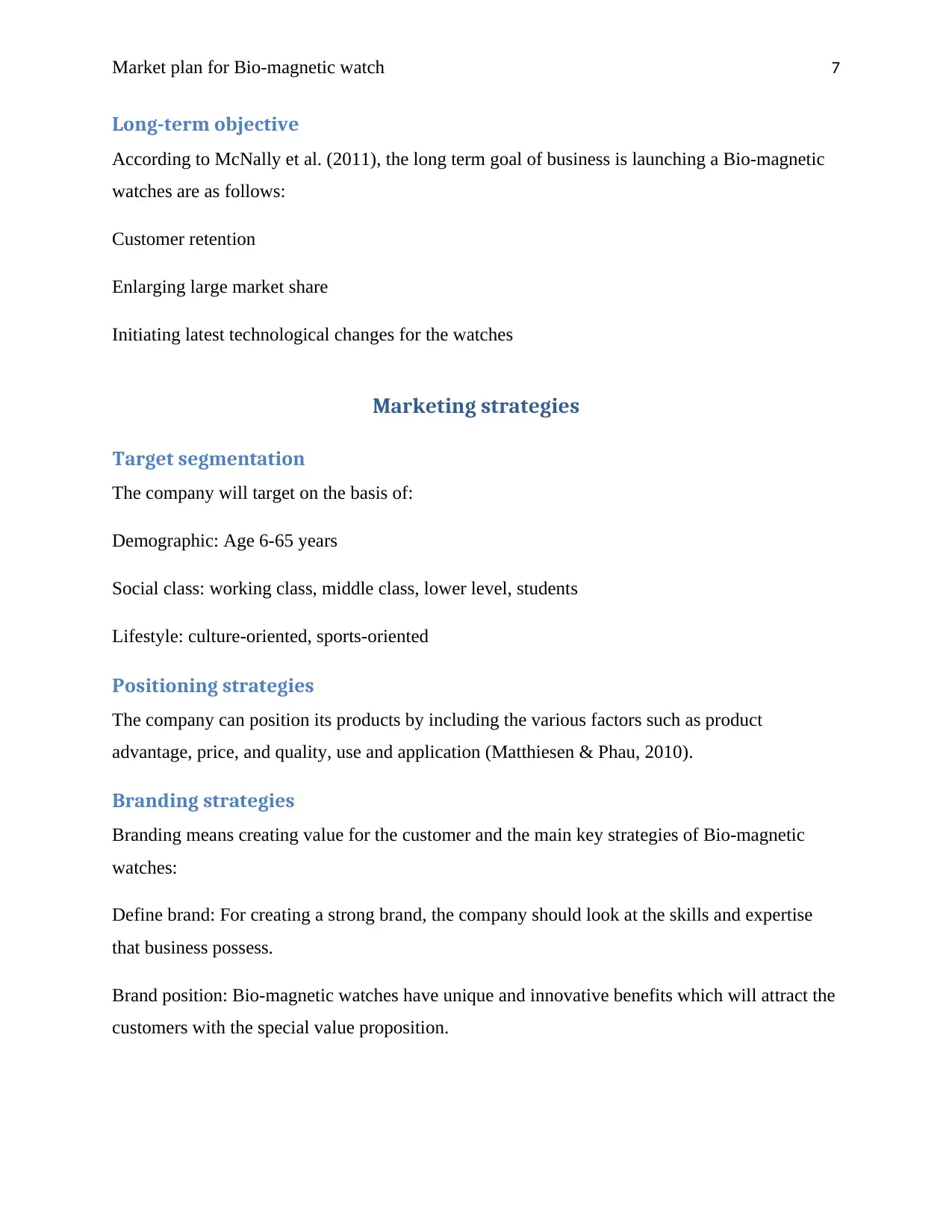
Market plan for Bio-magnetic watch 7
Long-term objective
According to McNally et al. (2011), the long term goal of business is launching a Bio-magnetic
watches are as follows:
Customer retention
Enlarging large market share
Initiating latest technological changes for the watches
Marketing strategies
Target segmentation
The company will target on the basis of:
Demographic: Age 6-65 years
Social class: working class, middle class, lower level, students
Lifestyle: culture-oriented, sports-oriented
Positioning strategies
The company can position its products by including the various factors such as product
advantage, price, and quality, use and application (Matthiesen & Phau, 2010).
Branding strategies
Branding means creating value for the customer and the main key strategies of Bio-magnetic
watches:
Define brand: For creating a strong brand, the company should look at the skills and expertise
that business possess.
Brand position: Bio-magnetic watches have unique and innovative benefits which will attract the
customers with the special value proposition.
Long-term objective
According to McNally et al. (2011), the long term goal of business is launching a Bio-magnetic
watches are as follows:
Customer retention
Enlarging large market share
Initiating latest technological changes for the watches
Marketing strategies
Target segmentation
The company will target on the basis of:
Demographic: Age 6-65 years
Social class: working class, middle class, lower level, students
Lifestyle: culture-oriented, sports-oriented
Positioning strategies
The company can position its products by including the various factors such as product
advantage, price, and quality, use and application (Matthiesen & Phau, 2010).
Branding strategies
Branding means creating value for the customer and the main key strategies of Bio-magnetic
watches:
Define brand: For creating a strong brand, the company should look at the skills and expertise
that business possess.
Brand position: Bio-magnetic watches have unique and innovative benefits which will attract the
customers with the special value proposition.
Paraphrase This Document
Need a fresh take? Get an instant paraphrase of this document with our AI Paraphraser
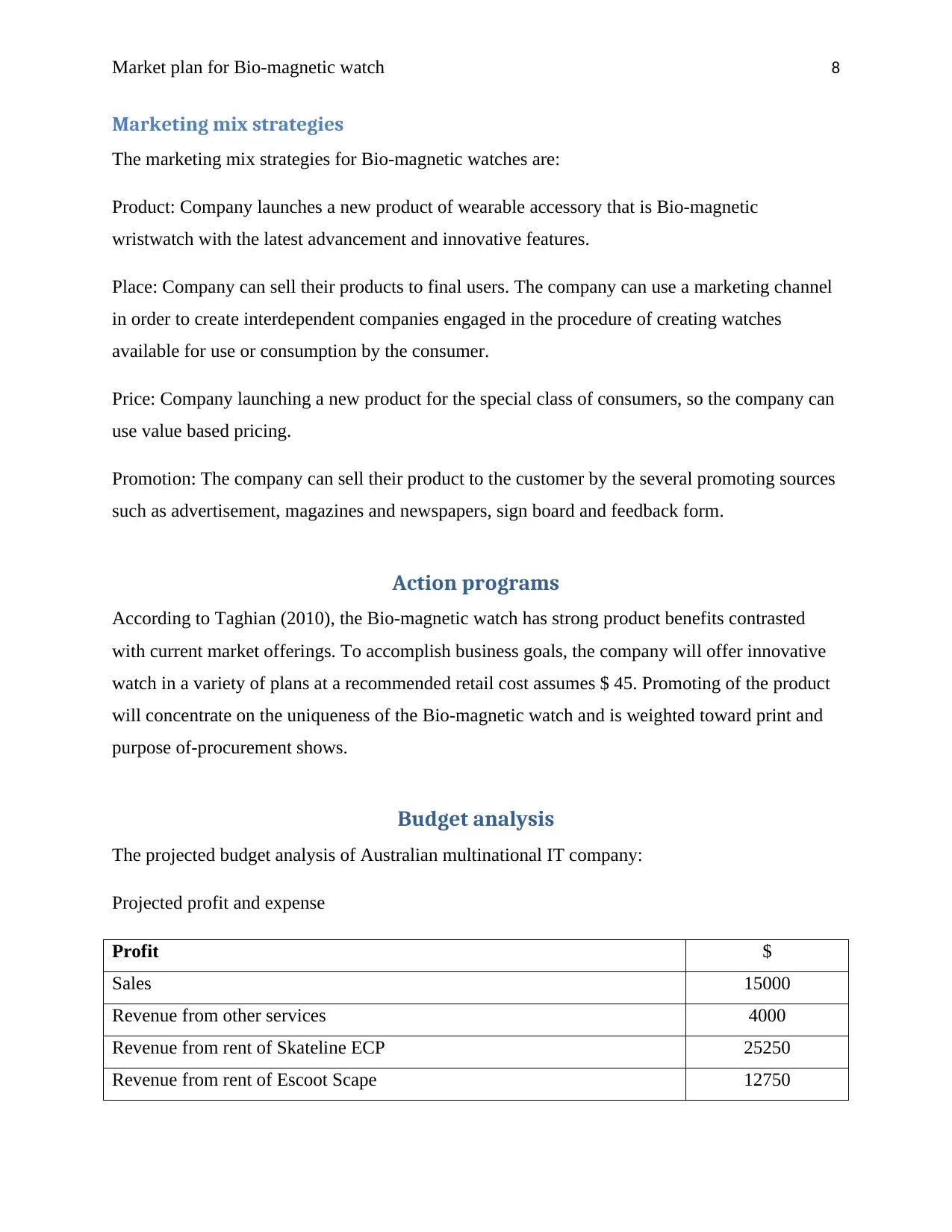
Market plan for Bio-magnetic watch 8
Marketing mix strategies
The marketing mix strategies for Bio-magnetic watches are:
Product: Company launches a new product of wearable accessory that is Bio-magnetic
wristwatch with the latest advancement and innovative features.
Place: Company can sell their products to final users. The company can use a marketing channel
in order to create interdependent companies engaged in the procedure of creating watches
available for use or consumption by the consumer.
Price: Company launching a new product for the special class of consumers, so the company can
use value based pricing.
Promotion: The company can sell their product to the customer by the several promoting sources
such as advertisement, magazines and newspapers, sign board and feedback form.
Action programs
According to Taghian (2010), the Bio-magnetic watch has strong product benefits contrasted
with current market offerings. To accomplish business goals, the company will offer innovative
watch in a variety of plans at a recommended retail cost assumes $ 45. Promoting of the product
will concentrate on the uniqueness of the Bio-magnetic watch and is weighted toward print and
purpose of-procurement shows.
Budget analysis
The projected budget analysis of Australian multinational IT company:
Projected profit and expense
Profit $
Sales 15000
Revenue from other services 4000
Revenue from rent of Skateline ECP 25250
Revenue from rent of Escoot Scape 12750
Marketing mix strategies
The marketing mix strategies for Bio-magnetic watches are:
Product: Company launches a new product of wearable accessory that is Bio-magnetic
wristwatch with the latest advancement and innovative features.
Place: Company can sell their products to final users. The company can use a marketing channel
in order to create interdependent companies engaged in the procedure of creating watches
available for use or consumption by the consumer.
Price: Company launching a new product for the special class of consumers, so the company can
use value based pricing.
Promotion: The company can sell their product to the customer by the several promoting sources
such as advertisement, magazines and newspapers, sign board and feedback form.
Action programs
According to Taghian (2010), the Bio-magnetic watch has strong product benefits contrasted
with current market offerings. To accomplish business goals, the company will offer innovative
watch in a variety of plans at a recommended retail cost assumes $ 45. Promoting of the product
will concentrate on the uniqueness of the Bio-magnetic watch and is weighted toward print and
purpose of-procurement shows.
Budget analysis
The projected budget analysis of Australian multinational IT company:
Projected profit and expense
Profit $
Sales 15000
Revenue from other services 4000
Revenue from rent of Skateline ECP 25250
Revenue from rent of Escoot Scape 12750
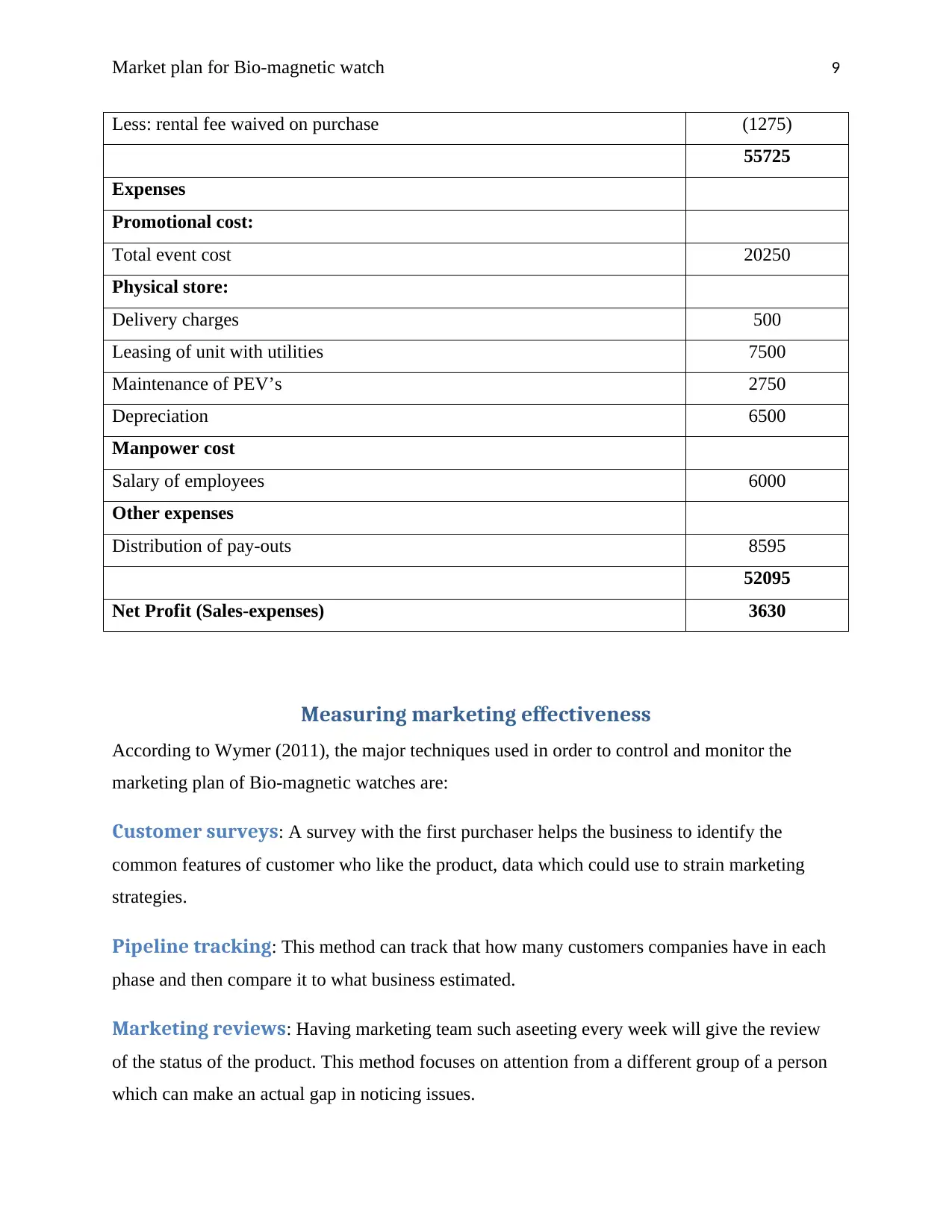
Market plan for Bio-magnetic watch 9
Less: rental fee waived on purchase (1275)
55725
Expenses
Promotional cost:
Total event cost 20250
Physical store:
Delivery charges 500
Leasing of unit with utilities 7500
Maintenance of PEV’s 2750
Depreciation 6500
Manpower cost
Salary of employees 6000
Other expenses
Distribution of pay-outs 8595
52095
Net Profit (Sales-expenses) 3630
Measuring marketing effectiveness
According to Wymer (2011), the major techniques used in order to control and monitor the
marketing plan of Bio-magnetic watches are:
Customer surveys: A survey with the first purchaser helps the business to identify the
common features of customer who like the product, data which could use to strain marketing
strategies.
Pipeline tracking: This method can track that how many customers companies have in each
phase and then compare it to what business estimated.
Marketing reviews: Having marketing team such aseeting every week will give the review
of the status of the product. This method focuses on attention from a different group of a person
which can make an actual gap in noticing issues.
Less: rental fee waived on purchase (1275)
55725
Expenses
Promotional cost:
Total event cost 20250
Physical store:
Delivery charges 500
Leasing of unit with utilities 7500
Maintenance of PEV’s 2750
Depreciation 6500
Manpower cost
Salary of employees 6000
Other expenses
Distribution of pay-outs 8595
52095
Net Profit (Sales-expenses) 3630
Measuring marketing effectiveness
According to Wymer (2011), the major techniques used in order to control and monitor the
marketing plan of Bio-magnetic watches are:
Customer surveys: A survey with the first purchaser helps the business to identify the
common features of customer who like the product, data which could use to strain marketing
strategies.
Pipeline tracking: This method can track that how many customers companies have in each
phase and then compare it to what business estimated.
Marketing reviews: Having marketing team such aseeting every week will give the review
of the status of the product. This method focuses on attention from a different group of a person
which can make an actual gap in noticing issues.
⊘ This is a preview!⊘
Do you want full access?
Subscribe today to unlock all pages.

Trusted by 1+ million students worldwide
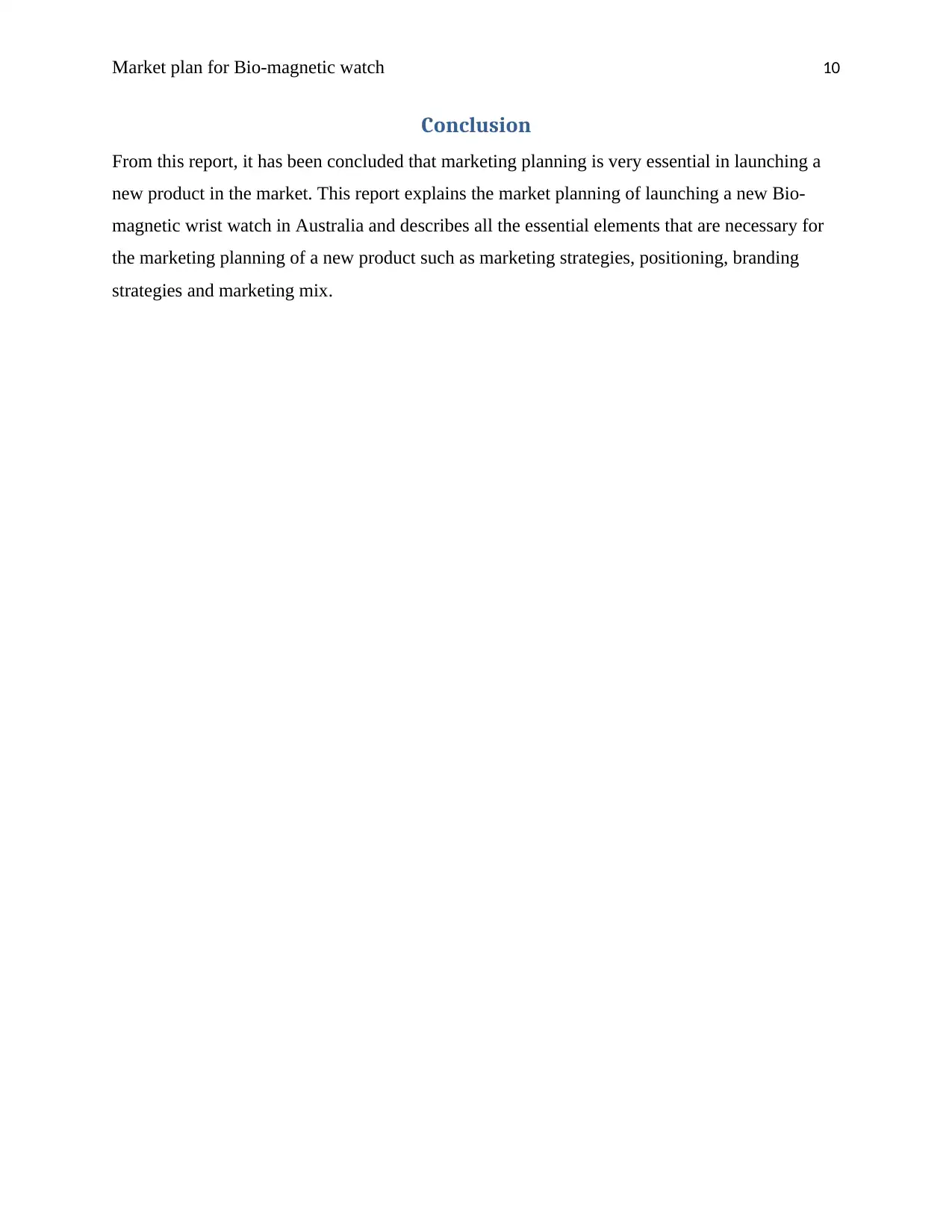
Market plan for Bio-magnetic watch 10
Conclusion
From this report, it has been concluded that marketing planning is very essential in launching a
new product in the market. This report explains the market planning of launching a new Bio-
magnetic wrist watch in Australia and describes all the essential elements that are necessary for
the marketing planning of a new product such as marketing strategies, positioning, branding
strategies and marketing mix.
Conclusion
From this report, it has been concluded that marketing planning is very essential in launching a
new product in the market. This report explains the market planning of launching a new Bio-
magnetic wrist watch in Australia and describes all the essential elements that are necessary for
the marketing planning of a new product such as marketing strategies, positioning, branding
strategies and marketing mix.
Paraphrase This Document
Need a fresh take? Get an instant paraphrase of this document with our AI Paraphraser
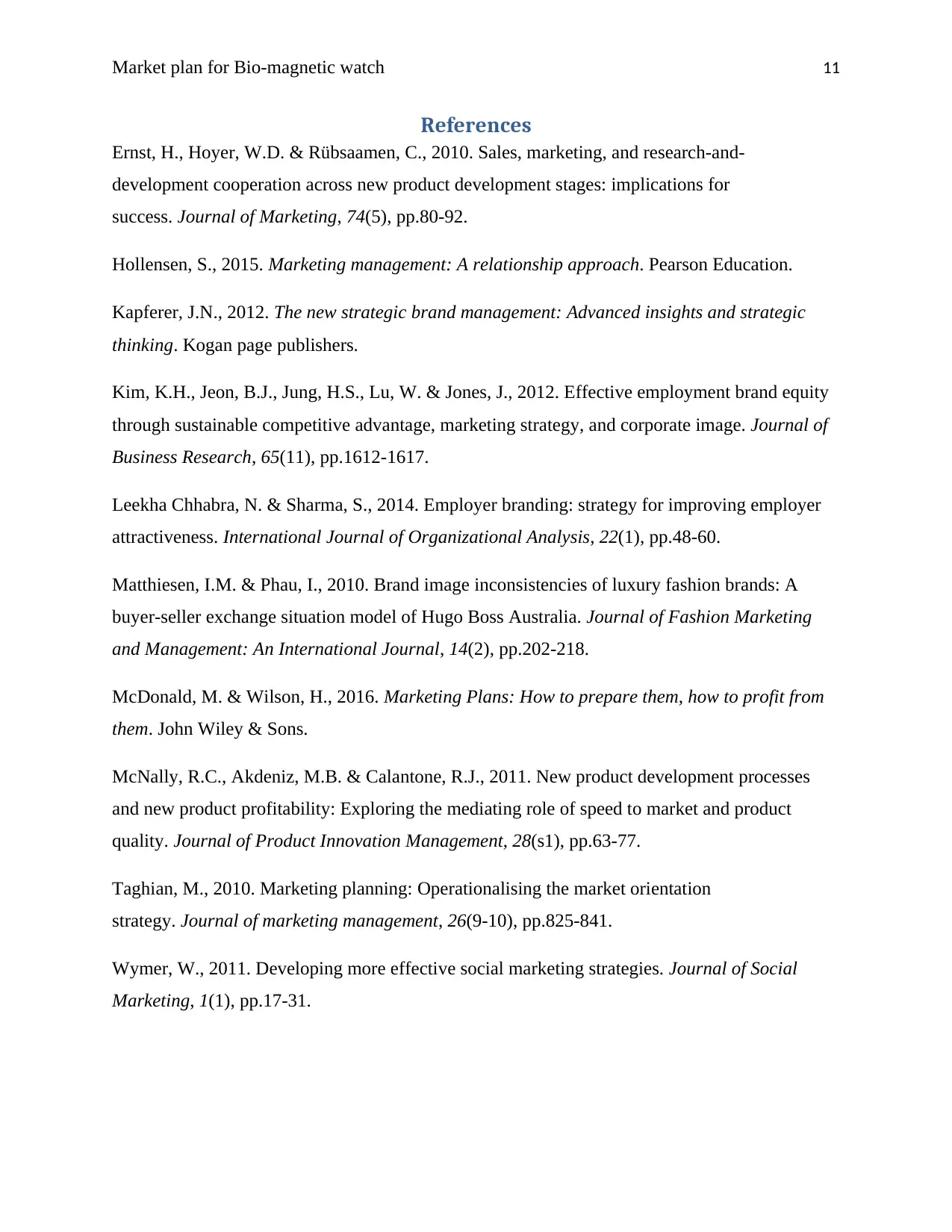
Market plan for Bio-magnetic watch 11
References
Ernst, H., Hoyer, W.D. & Rübsaamen, C., 2010. Sales, marketing, and research-and-
development cooperation across new product development stages: implications for
success. Journal of Marketing, 74(5), pp.80-92.
Hollensen, S., 2015. Marketing management: A relationship approach. Pearson Education.
Kapferer, J.N., 2012. The new strategic brand management: Advanced insights and strategic
thinking. Kogan page publishers.
Kim, K.H., Jeon, B.J., Jung, H.S., Lu, W. & Jones, J., 2012. Effective employment brand equity
through sustainable competitive advantage, marketing strategy, and corporate image. Journal of
Business Research, 65(11), pp.1612-1617.
Leekha Chhabra, N. & Sharma, S., 2014. Employer branding: strategy for improving employer
attractiveness. International Journal of Organizational Analysis, 22(1), pp.48-60.
Matthiesen, I.M. & Phau, I., 2010. Brand image inconsistencies of luxury fashion brands: A
buyer-seller exchange situation model of Hugo Boss Australia. Journal of Fashion Marketing
and Management: An International Journal, 14(2), pp.202-218.
McDonald, M. & Wilson, H., 2016. Marketing Plans: How to prepare them, how to profit from
them. John Wiley & Sons.
McNally, R.C., Akdeniz, M.B. & Calantone, R.J., 2011. New product development processes
and new product profitability: Exploring the mediating role of speed to market and product
quality. Journal of Product Innovation Management, 28(s1), pp.63-77.
Taghian, M., 2010. Marketing planning: Operationalising the market orientation
strategy. Journal of marketing management, 26(9-10), pp.825-841.
Wymer, W., 2011. Developing more effective social marketing strategies. Journal of Social
Marketing, 1(1), pp.17-31.
References
Ernst, H., Hoyer, W.D. & Rübsaamen, C., 2010. Sales, marketing, and research-and-
development cooperation across new product development stages: implications for
success. Journal of Marketing, 74(5), pp.80-92.
Hollensen, S., 2015. Marketing management: A relationship approach. Pearson Education.
Kapferer, J.N., 2012. The new strategic brand management: Advanced insights and strategic
thinking. Kogan page publishers.
Kim, K.H., Jeon, B.J., Jung, H.S., Lu, W. & Jones, J., 2012. Effective employment brand equity
through sustainable competitive advantage, marketing strategy, and corporate image. Journal of
Business Research, 65(11), pp.1612-1617.
Leekha Chhabra, N. & Sharma, S., 2014. Employer branding: strategy for improving employer
attractiveness. International Journal of Organizational Analysis, 22(1), pp.48-60.
Matthiesen, I.M. & Phau, I., 2010. Brand image inconsistencies of luxury fashion brands: A
buyer-seller exchange situation model of Hugo Boss Australia. Journal of Fashion Marketing
and Management: An International Journal, 14(2), pp.202-218.
McDonald, M. & Wilson, H., 2016. Marketing Plans: How to prepare them, how to profit from
them. John Wiley & Sons.
McNally, R.C., Akdeniz, M.B. & Calantone, R.J., 2011. New product development processes
and new product profitability: Exploring the mediating role of speed to market and product
quality. Journal of Product Innovation Management, 28(s1), pp.63-77.
Taghian, M., 2010. Marketing planning: Operationalising the market orientation
strategy. Journal of marketing management, 26(9-10), pp.825-841.
Wymer, W., 2011. Developing more effective social marketing strategies. Journal of Social
Marketing, 1(1), pp.17-31.
1 out of 11
Related Documents
Your All-in-One AI-Powered Toolkit for Academic Success.
+13062052269
info@desklib.com
Available 24*7 on WhatsApp / Email
![[object Object]](/_next/static/media/star-bottom.7253800d.svg)
Unlock your academic potential
Copyright © 2020–2025 A2Z Services. All Rights Reserved. Developed and managed by ZUCOL.





